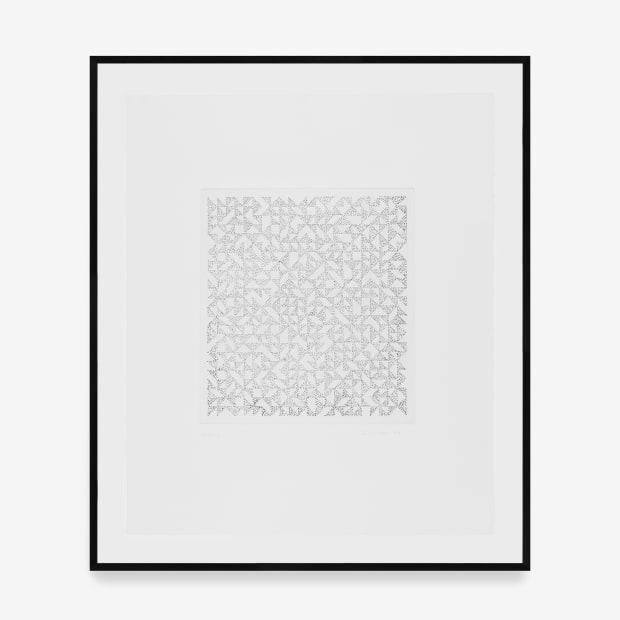-
-
'Art is something that makes you breathe with a different kind of happiness.'
—Anni Albers
Widely known today for their bodies of work in painting and textiles, the oeuvres of Josef and Anni Albers as printmakers were of major import and influenced the vision of their artistic practices. Both artists were interested in the processes, possibilities, and limitations of various media that allowed their art to transform and move forward. In their focus on geometry and color, the Albers employ a universal visual language that brings a renewed sense of vitality to the viewer. As Josef Albers stated: “The aim of life is living creatures. The aim of art is living creations.”
Josef wished to eliminate “any additional ‘hand writing’ or, so-called texture” from his art. This desire is made manifest in prints such as EK Ia (1970), I-S f (1970), and Prefatio (1942). The former two are related to his Homage to the Square series, in which he strives to explore what he called the “exciting discrepancy between physical fact and psychic effect of color.” These reductionist abstract images demonstrate how colors interact with and react to each other–showcasing the dynamic and fluctuating nature of color and how it changes according to its environment. Alternatively, Prefatio, one of his early lithographs created during the 1940s at the Black Mountain College, demonstrates Josef’s interest in line and its efficacy to create complex images without the intervention of other elements. This complexity is due to the alterations in the thickness or thinness of the lines, their systematic dispersal, and the steadily decreasing or increasing length. All three works express Josef’s interest in geometry and color as a universal language due to their ability to transcend both borders and time.
Anni Albers’ Camino Real (1967-1969) was created in parallel to the textile work of the same title completed in 1968. Subtle tonal variations, the lack of pattern in the organization of positive versus negative space, and how the triangles lead the viewer’s eyes diagonally around the image create a sense of movement that enlivens this dynamic work. The triangular shapes of this composition carry over into her Triangulated Intaglio I (1976) and Triangulated Intaglio II (1976). When creating these two works, Anni opted for the intaglio rather than using the screen-printing method which rose in popularity in the 1960s during the so-called American Renaissance in printmaking. In returning to this older form of printmaking that was popular during the Italian Renaissance, Anni demonstrates how her interest in working with different media is not limited to new technologies. These works still connect to her screenprint, however, through their compositions that are rhythmic but not repetitive or symmetrical. Printmaking was an essential medium for Anni, for it allowed her to produce crisp diagonal lines that were unobtainable in weavings. These three works reveal how printmaking allowed Anni to break from the focus on horizontality and verticality in her weavings and achieve the clarity that was so important to her.
The Albers’ artistic practices set examples of experimentation, both in terms of formal investigation as well as in expanding the possibilities of the media. Pioneers of exploring new avenues of abstraction, the clarity and precision of their works deeply impacted post-war abstraction in the United States and abroad. Josef and Anni’s artistic legacy left a powerful mark as a result of their travels, their valuable writings on their practices, and their roles as teachers and mentors at the Bauhaus, the Black Mountain College and the Yale School of Art. Their legacy endures through notable students, friends, and admirers such as Robert Rauschenberg, Lygia Pape, Ruth Asawa, Robert Mangold, and Sheila Hicks among others.
-
-

Anni Albers
Camino Real, 1967-1969Screenprint on Mohawk Superfine Bristol paper
23 1/2 x 22 in (59.7 x 55.9 cm)
Edition of 90, plus 12 AP -
-

-

-
-

Josef Albers
Prefatio, 1942Lithograph on Serie Whitewove paper
19 x 24 in (48.2 x 61 cm)
Edition of 30 -
-

-

Josef & Anni Albers
Past viewing_room






